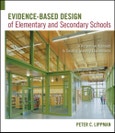The contemporary school must be a vibrant, living extension of its community. Evidence–Based Design of Elementary and Secondary Schools instructs design professionals on how to successfully achieve this goal. With assistance from research–intensive principles grounded in theories, concepts, and research methodologies and with roots in the behavioral sciences this book examines and provides strategies for pooling streams of information to establish a holistic design approach that is responsive to the changing needs of educators and their students. This book:
-
Delivers an overview of the current research and learning theories in education, and how they apply to contemporary school design
-
Explores the history of school design in the United States
-
Examines the role of information technology in education
-
Includes case studies of more than twenty exemplary school designs, based on research of the best physical environments for learning and education
-
Considers what learning environments may be in the near future
Evidence–Based Design of Elementary and Secondary Schools analyzes the current shift toward a modern architectural paradigm that balances physical beauty, and social awareness, and building technologies with functionality to create buildings that optimize the educational experience for all learners. Enlightening as well as informative, this forward–thinking guide provides educational facility planners, designers, and architects with the tools they need to confidently approach their next school building project. In addition, this guide provides administrators, educators, and researchers with design options for rethinking and creating innovative learning environments.
Table of Contents
Preface ix
Acknowledgments xi
Chapter 1: Where Does Evidence–Based Design Fit in the Design Process for Creating Responsive Learning Environments? 1
Introduction 1
Thinking Beyond the Aesthetic 2
Normative Theories 3
Changing the Role of the Architect 6
Innovation in Design: Historical Overview 7
Extending Design: A Responsive Approach 9
Places for Learning: Primary and Secondary Environments 10
Evaluating Settings as Passive and Active 14
References 15
Chapter 2: Responsive Design Approach: Defining Intentions 19
Introduction 19
Behavior Settings 19
Communities of Practice 20
Recognizing Schools as Learning Communities 22
Two Ends of the Spectrum: Resistant and Reactive Design Approaches 23
The Reflexive Design Approach 27
The Responsive Design Approach 29
References 37
Chapter 3: Understanding Practice–Based Evidence, Evidence–Based Design, and Responsive Research as Approaches for Guiding the Design of Learning Communities 39
Introduction 39
Research Methodologies 42
Case Studies 43
Ethnography 43
Postoccupancy Evaluation 44
Specific Programmatic Purposes of Research 52
Research in Practice: Programming 60
Conclusion 68
References 73
Chapter 4: Historical Overview of School Design in the United States 75
Introduction 75
Colonial Period: Resistant Design 75
Industrial Period: Reflexive in Execution 76
Progressive Era: Responsive in Idea and Reflexive in Execution 78
Crow Island School: A Responsive Approach to Design 82
Modern Era 84
Postmodern Era 88
Twenty–First–Century School Design 94
References 96
Chapter 5: Technology in Education 101
Introduction 101
A Brief History of Instructional Technology Use and Alternative Learning Environments 102
The History of the Internet 105
The Open University 107
Information Technology, Cyberspace, and Environmental Psychology 111
Use of Instructional/Information Technology 112
The Distance Learning Environment 113
Distance Learning: Synchronous to Asynchronous 114
Considerations for Virtual Classroom Design 115
References 124
Chapter 6: Learning Theories 127
Introduction 127
Genetic Determinism 127
Behaviorism 129
Theory of Multiple Intelligences, Constructivism, and Social Constructivism 129
The Reactive Design Approach in Relation to Constructivism 133
Practice Theory 134
Practice Theory and Its Relationship to the Situated Nature of Knowledge Acquisition 135
Conclusion 140
References 140
Chapter 7: Models for Twenty–First–Century Schools 143
Introduction 143
Reggio Emilia, Montessori, and Waldorf 144
Twenty–First–Century Learning Communities 155
Twenty–First–Century Learning Environments: Nothing New Under the Sun 158
Conclusion 164
References 166
Chapter 8: Promoting a Framework for the Design of Learning Communities 169
Introduction 169
Constraints and Affordances of Creating Small Schools 169
Considerations for How to Grow the Learning Community 177
Guidelines for Creating Learning Communities 179
Four Stages of Personalization 190
Pattern for the Design of Learning Communities 191
Primary Patterns: Administration, Athletic, Science, Art and Music, Media, and Cafeteria Precincts, and Neighborhoods within the Learning Community 193
Secondary Patterns: Streets, Common Areas Outside the Home, Porch, and Home 198
Tertiary Patterns: Fixed Features, Sociohistorical Elements, Transparency, and Ceiling Heights 204
Conclusion 206
References 206
Chapter 9: Case Studies: Elementary Schools, Middle Schools, High Schools, Urban Schools, Specialized Schools, Private Schools, and Community Schools 211
Elementary Schools 213
Middle Schools 231
High Schools 245
Urban Schools 259
Specialized Schools 274
Private Schools 292
Community Schools 309
References 316
Chapter 10: Next Steps for the Twenty–First Century 317
Introduction 317
Democratic Ideals, Individualism, and Situated Learning 317
Practice Theory and Twenty–First–Century Learning 318
Overview of Methods 320
Conclusion and Recommendations 324
References 327
Index 329








